Growing Together
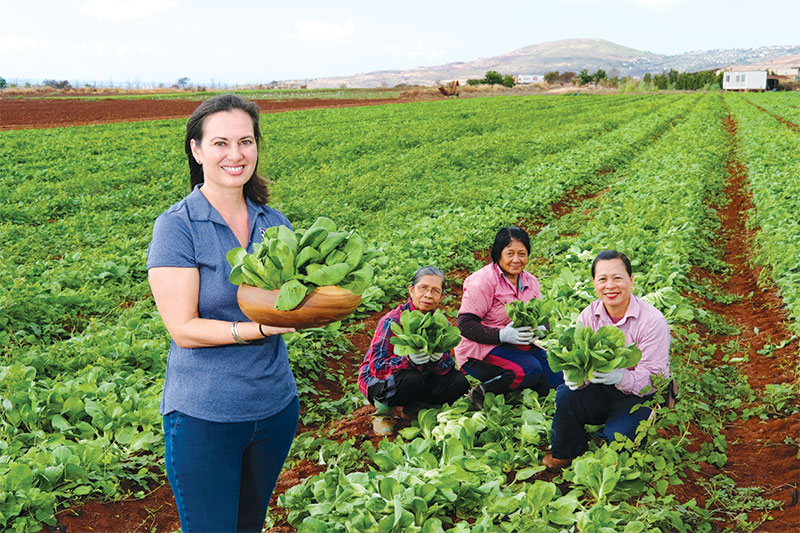
Amy Miller, president and CEO of Hawai‘i Foodbank (Top, from left) Aloun Farms ~ eld workers Estrelita Pascua and Jacqueline Maneja, and field supervisor Cherolyn Dumaoa
Through thriving programs and expanding partnerships, Hawai‘i Foodbank is meeting the sustenance demands of residents across the state.
Anticipation runs high for Thanksgiving, a holiday in which indulging in food comas and loosening belt buckles are badges of honor, and going for second, third or even fourth servings is encouraged.
Yet, this enticing scene isn’t reality for many residents. Nearly a quarter of a million people in the state, including 1 in 4 children, face food insecurity. Simply put, they lack access to enough food to live an active, healthy life — and with groceries costs higher than ever (there was a 25% surge post-pandemic), the number is only rising.
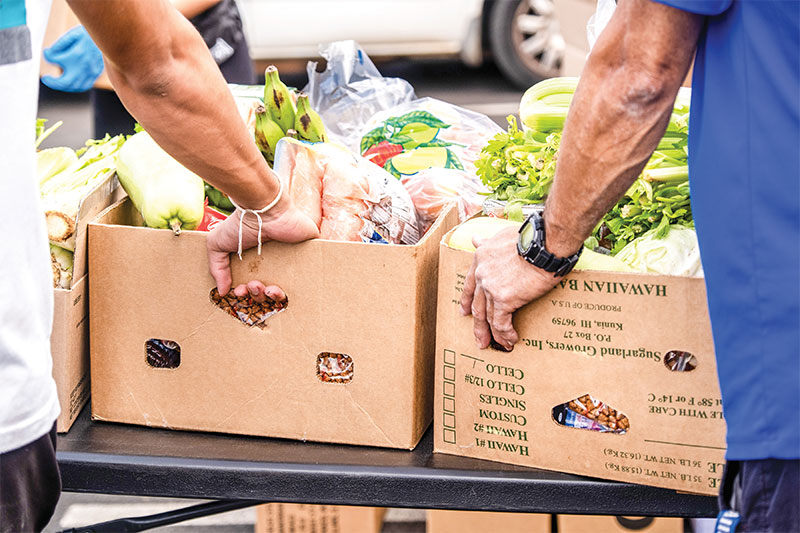
One-quarter of Hawai‘i Foodbank’s distributions are fresh produce, with a large majority coming from local farms.
As it marks its 40th anniversary, Hawai‘i Foodbank reflects on decades of nourishing ‘ohana while envisioning a future where its services are no longer needed.
Leading the way is Amy Miller, a Seattle native who joined the nonprofit in 2021 following roles at Bishop Museum and the Academy of Natural Sciences of Drexel University. Her credentials shine with a degree from Harvard University and experience in environmental science, public policy and fundraising.
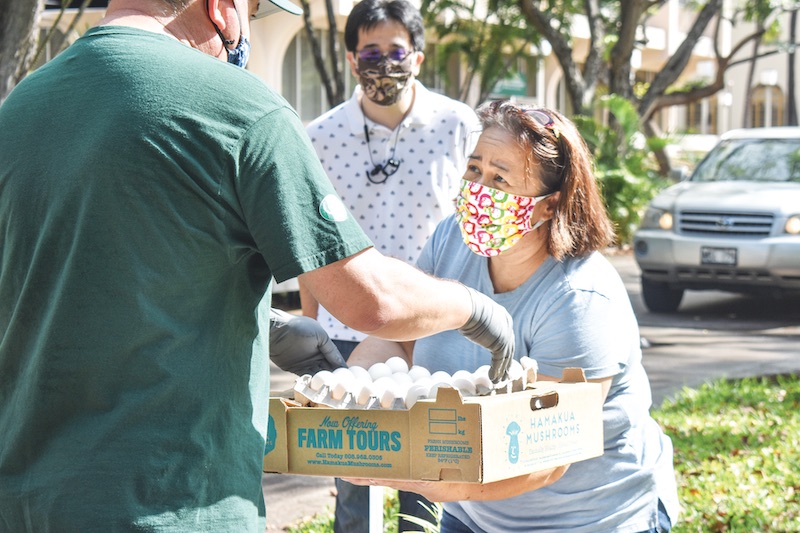
One-quarter of Hawai‘i Foodbank’s distributions are fresh produce, with a large majority coming from local farms.
However, prior to becoming president and CEO of the official food bank for the state, Miller admits she didn’t know much about it.
“I supported the food bank both here and in Philadelphia, but I don’t think I really understood what the food bank did,” she says. “I think I imagined that it was — I don’t know what I thought, really. Maybe I thought of it more like a pantry, a place where you can go get food if you need help.”
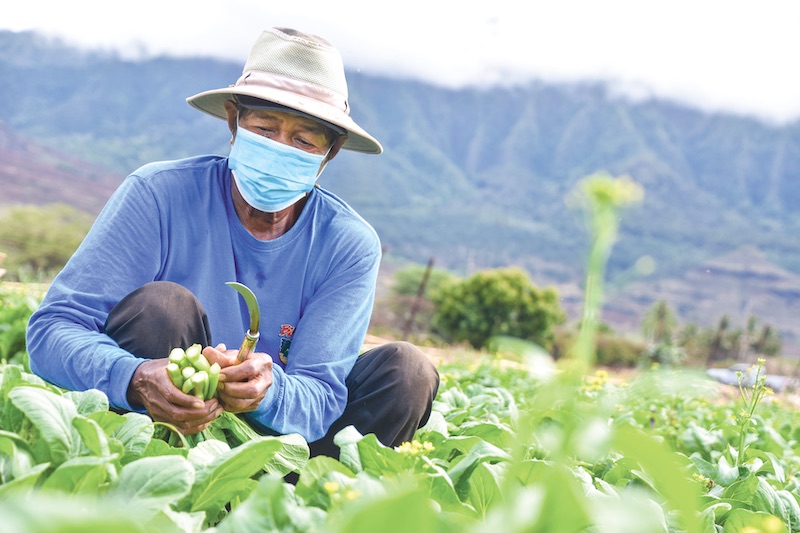
One-quarter of Hawai‘i Foodbank’s distributions are fresh produce, with a large majority coming from local farms.
When she came on board in the middle of the pandemic, her mind was blown by the complexity of the food bank’s business model. As the largest hunger-relief operation in Hawai‘i, the organization supports 1 in 6 residents weekly through its network of 200 agency partners on O‘ahu and Kaua‘i, along with Maui Food Bank and The Food Basket on Hawai‘i island.
Like Miller, folks may not have considered the food bank’s strategy beyond its core mission of getting food to those in need. So, it may be news to some that the organization primarily acts as a hub for food collection rather than directly handling distribution itself. It gathers food from various places, like grocery stores as part of its retail rescue initiative, and food drives held by schools and businesses. Volunteers verify the food’s safety and quality before distributing it throughout the community via nonprofits, soup kitchens, homeless shelters, churches and schools.
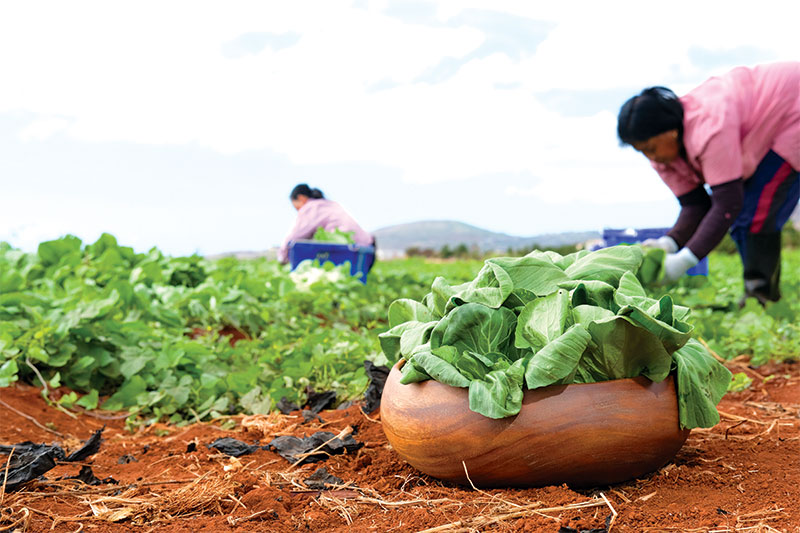
One-quarter of Hawai‘i Foodbank’s distributions are fresh produce, with a large majority coming from local farms.
“From the perspective of the people that we serve, they don’t have to go to this big giant food bank with big giant distributions,” says Miller. “The idea is they can go in their own community to an organization, church or group who’s there to support you and you can build those relationships and get the help that you need.
“I really love that because putting the people we serve at the center of all that we do is one of the notches of our new strategic plan,” she adds. “We’re here to support the community and the people, and we want to make the experience as dignified, easy and supportive as possible so that people can get access to the food that they need for their families.”
Just 60 years ago, food banks were nonexistent. While food pantries and soup kitchens were a thing, the idea of a centralized warehouse that saves viable food was merely a myth. The first food bank started in Phoenix, Arizona, in the ’60s, and 20 odd years later, John White and Ron Keith were inspired by the concept and opened a quaint warehouse on Sand Island with the hope of providing meals for their neighbors. The community rallied together and donated a flatbed truck, two refrigerated containers and a 3-ton forklift in no time. In its first year, the food bank distributed 380,000 pounds of food through 75 agency partners (more than 20 of which are still working with the food bank today).
“This idea of distributing out food through community partners was in the model right from the start,” says Miller. “Then we kind of started food drives not too long after to really get the community more involved and thinking about food insecurity and how we as a community could combat food insecurity and hunger in Hawai‘i.”
For years, the food bank carried on with generally the same model of recovering unsellable groceries and collecting donated canned items. In 1997, a few years after obtaining a warehouse in Māpunapuna, the same one it uses today, the organization launched the ‘Ohana Produce Program with the goal of salvaging more than 1 million pounds of fresh produce. Over the years, the program evolved to include other items such as baked goods, dairy, eggs, cereal, snacks, beverages, canned goods and more.
In 2015, it launched the Senior Food Box program, which provides kūpuna with supplemental foods such as non-fat dry milk, cereal, milk, juice, peanut butter, rice, canned meat, fruits and vegetables. And in 2018, it started the Food 4 Keiki School Pantry Program began, which offers food to children during school hours and provides them with a 5-pound bag to take home for the weekend.
“The idea of not being able to put a healthy meal on the table for my kids is heartbreaking,” says Miller, a mother of two. “We know from research that parents and grandparents will often go without food so they can get food on the table for their families. We also know by talking to teachers that they’re often buying snacks out of their pockets to have something for kids.
“I know that there’s a stigma attached to asking for help. Many times, we see folks that come to a distribution for the first time and it’s really, really hard for them to ask for help,
but we feel like it shouldn’t be hard. You deserve it. Everyone deserves safe and healthy food, and it shouldn’t be something you’re embarrassed about. For us that’s something that we would like to do — just be sure people know that there’s help out there and they shouldn’t be ashamed to ask.”
When the pandemic struck, the food bank served 60% more people than the year prior and increased its food purchases by a whopping 3,000%. The usual quantities weren’t cutting it, and families who had never sought assistance before were now relying on the food bank for survival. In response, the organization boosted its existing programs, launched pop-up food distributions for vulnerable households and worked with lawmakers to strengthen Hawai‘i’s emergency food assistance programs.
Also during the shutdown era, farmers were faced with a challenge: Their crops continued to grow without anyone to sell it to. So, the food bank joined forces with Hawai‘i Farm Bureau to purchase the surplus stock. This partnership not only rescued the excess produce but also served as a lifeline for farmers grappling with disrupted supply chains. This collaboration laid the groundwork for Farm to Food-bank, a program which, after just two years, expanded to procure 20,000-30,000 pounds of fresh produce weekly from 20 farms and food hubs.
“From a farmer’s perspective, we can be that last resort because we don’t care what it is and what it looks like,” says Miller. “We’re not picky about certain items because we know we’ll get it out to different families; it doesn’t have to be a beautiful or perfect produce that you might see on the shelf at Whole Foods. That’s something that we’re really proud of and continue to grow.
“Right now, more than a quarter of the food we distribute is fresh produce, and that wasn’t in my vision of what food banks did at all,” she adds. “But now I’m really proud to be here and be a part of an organization that takes nutrition seriously. We’re working hard to make sure that we’re able to get fresh and healthy food to those we serve.”
Another byproduct of the pandemic: The organization sources items from food banks on the mainland. In Hawai‘i, $5 buys get just one or two cans of tuna, whereas the same amount can fetch 12-15 cans on the continent. Additionally, West Coast food banks have generously dispatched crates of apples, oranges, potatoes, butternut squash and other fresh produce that isn’t typically grown here.
“That’s how we’ve been able to really get our numbers up in terms of produce. I think last year we distributed about 5 million pounds of fresh produce,” says Miller.
“It’s really hard to make ends meet and we know that people will make a lot of sacrifices to put a meal on the table for their families,” she adds. “Oftentimes they’ll make choices about the kinds of food, and we know fresh produce is one of the things that falls off people’s grocery lists because it’s expensive and doesn’t last, so people will gravitate and pivot toward less expensive but sometimes highly processed and less healthy foods. We can see that food insecurity is highly correlated with these really negative health outcomes around heart disease and diabetes.”
For those interested in getting involved, Miller suggests donating time or money. There are countless volunteer positions, from inspecting food to loading cars and assisting with traffic control at distributions, and while donating non-perishable food items has traditionally been deemed the best way to support the local food bank, Miller debunks the theory.
“We’re trying to encourage people that donating $1 through a food drive is sometimes even more effective than donating food,” she says. “It’s hard for a lot of folks because they want the hands-on feeling … and sometimes it doesn’t feel the same to write a check or put your credit card in an online giving space, but it is a really efficient way to contribute because we can really stretch that dollar in a way that we can’t do on our own at home.
“My kids have their food drives at school and there is something so tangible about it,” she continues. “I love how food banks can help develop that culture of philanthropy. It’s really tangible to think, ‘This food is going to be a meal for somebody.’ If you have food in your pantry that you’re not going to eat, go ahead and donate it to the food bank, but don’t necessarily go out and buy $20 worth of food at the store and donate it. We can stretch that $20 much further.”
As for what’s in store for the next 40 years? Well, Miller hopes to be out of a job.
“That’s really what motivates me is driving toward the vision to where maybe we don’t exist. If we’re really doing our job, we don’t want to be doing the same thing years from now. We want to really make a significant dent that 20 or 40 years from now we don’t have to serve at the same level because we’ve broken the cycle.”



